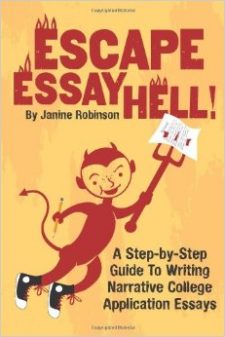College Admissions Essays:
How to Start Your Core College Application Essay
If you are writing a college admissions essay that responds to a prompt that asks you to tell about yourself, or about “a time,” or describe a quality, background, interest, identity, talent, characteristic, experience or accomplishment (such as The Common App prompts or Prompt #2 for the UC app.), then your essay is also known as a personal statement.
The most effective personal statements are written as narrative essays, meaning they relate an experience using a story-telling style.
To share an incident or moment from your past, you only need two components to make a story: a character and a conflict.
So one magic way to create a personal narrative is to search your recent past for a conflict. (You are the “character.”)
Thinking back to English class, remember that conflicts can come from many different places—from within yourself (internal: you have a personal issue or hang-up that caused you pain or trouble) to outside yourself (external: something happened to you.)
To put it simply, a conflict is a problem.
Problems come in all shapes and sizes.
They do not need to be traumas or a crises, although those can work, too.
(HINT: Basic, everyday problems work best! Check out this post about “mundane” topics.)
Here are other words for a conflict or problem: challenge, failure, obstacle, mistake, hang-up, issue, a change, dilemma, fears, obsessions, etc.
Examples of conflicts or problems: you are shy, competitive, stubborn, were bullied, are obsessed with Twilight, didn’t make the team, got injured, have big feet, frizzy red hair, smile too much, someone quit at your work, don’t have own car, can’t spell, adhd, ocd, don’t eat meat, perfectionist, slob, lazy, drunk driving, have a mean grandparent, no money, etc…
Man, there are a lot of problems out there! But for the purposes of writing these dreaded essays, that’s a good thing for once!
Once you remember a juicy problem, follow these steps:
1. Describe the time you had a problem or describe a strong example of your problem.
(Include what happened and how it made you feel. Try to start at the moment it hit, or happened for the best impact! Include the 5Ws—who, what, when, where and why! Stick to one or two paragraphs.)
These mini-stories are also called anecdotes, and you can learn more by reading my post on how to write an anecdote.
RELATED: My Video Tutorial on How to Write an Anecdote: Part One
2. Background the history of this problem (when did it start, why/how did it happen or get this way.) “It all started back when…”
3. Talk about how you dealt with that problem. What you did about it. Steps you took to handle it.
4. Reflect on that problem. How did you think about it? How did you feel? Did handling it change you in any way or how you think about things? Share your thoughts.
5. What did you learn from dealing with that problem–about yourself, others or life in general?
Anything good come out of it? Did you develop or demonstrate a core quality—determination, problem-solving, creativity, passion, patience, respect—in the process? Talk about that.
6. Conclusion: (Look back at what you learned and see what personal qualities or characteristics you used or developed while dealing with this problem–aha, there’s the answer to your UC prompt!)
In your conclusion, discuss how you would/could use these qualities or characteristics, or what you learned, in your future endeavors.
Chances are you have the beginning of a personal narrative.
You told a story about yourself where you encountered a problem, and it affected you in some way, which you then explain, analyze and share with the reader.
Yes, this is a formula—but it is as old as time.
It’s called Telling a Story!
The best thing about this style of writing is that it is also naturally very compelling to read.
If you want to see an example of how I step through this process with a real student, read Work First, Surf Second.
What you have at this point is a rough draft–so make sure and read my other posts to learn ways to kick your college admissions essay into a brilliant piece of writing!!
Still looking for a story topic? Try this Topic Brainstorm Guide.
Read The Good, Bad and Ugly for some tips on writing your Common App essay.
RELATED: My Video Tutorial on How to Answer Common App Prompt 4: What’s Your Problem?
Once you are done, make sure to use this FINAL CHECKLIST before you send it off.







I think was a good way for me to help me out on my college essay/personal statement because it lays it out in six easy steps. They make it easy to figure out what are good ways to make your essay stand out amongst the other entrires.
THANK YOU, great information.
eye opener. thanks
i really have no idea how to start this prompt ? any ideas ?